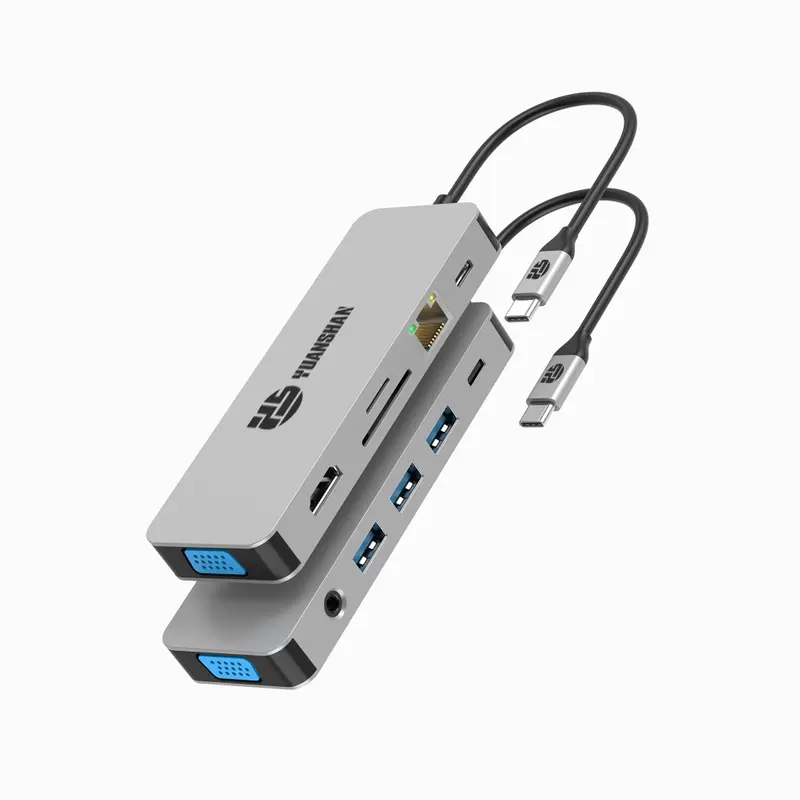USB-C is a universal connector that has become the standard for many devices, including smartphones, laptops, and tablets. Thunderbolt, on the other hand, is a high-speed data transfer technology that was developed by Intel and is used primarily for connecting external devices to computers. While both USB-C and Thunderbolt use the same physical connector, they are not the same technology and have different capabilities.
Overview of Thunderbolt technology and USB-C connectorsComparison of Thunderbolt and USB-C capabilitiesExamples of Thunderbolt docking stations and their featuresConclusion

Overview of Thunderbolt technology and USB-C connectors
Thunderbolt is a high-speed data transfer technology that was developed by Intel in collaboration with Apple. It was first introduced in 2011 and has since gone through several iterations, with Thunderbolt 3 and 4 being the most recent. Thunderbolt technology allows for the transfer of data, video, and power through a single cable and connector.
USB-C, on the other hand, is a universal connector that has become the standard for many devices, including smartphones, laptops, and tablets. It was introduced in 2014 and has quickly gained popularity due to its small size and versatility. USB-C connectors can be used for data transfer, video output, and charging, making them a convenient option for many devices.
While both Thunderbolt and USB-C use the same physical connector, they are not the same technology. Thunderbolt is a proprietary technology that requires specific hardware to function, while USB-C is a universal standard that can be used with a wide range of devices.
Comparison of Thunderbolt and USB-C capabilities
Thunderbolt technology is known for its high-speed data transfer capabilities. Thunderbolt 3 and 4 can transfer data at speeds of up to 40 Gbps, which is four times faster than USB 3.1 and eight times faster than USB 3.0. This makes Thunderbolt an ideal option for transferring large files, such as video and audio, and for connecting external devices, such as hard drives and monitors.
In addition to high-speed data transfer, Thunderbolt also supports daisy chaining, which allows multiple devices to be connected to a single Thunderbolt port. This is a convenient option for users who need to connect multiple devices to their computer but have limited ports available. Thunderbolt also supports the transfer of video and power, making it a versatile option for connecting external devices.
USB-C, on the other hand, is a more versatile connector that can be used with a wide range of devices. USB-C connectors can be used for data transfer, video output, and charging, making them a convenient option for many devices. USB-C connectors are also reversible, meaning they can be plugged in either way, which is a convenient feature for users.
While USB-C is not as fast as Thunderbolt, it is still a fast option for data transfer. USB-C 3.1 can transfer data at speeds of up to 10 Gbps, which is faster than USB 3.0 but slower than Thunderbolt. USB-C is also a more affordable option than Thunderbolt, making it a popular choice for many users.
Examples of Thunderbolt docking stations and their features
Thunderbolt docking stations are becoming increasingly popular as more devices are equipped with Thunderbolt ports. These docking stations allow users to connect multiple devices to their computer through a single Thunderbolt port, making them a convenient option for users who need to connect multiple devices.
One popular Thunderbolt docking station is theCalDigit TS3 Plus. This docking station features 15 ports, including a Thunderbolt 3 port, USB-A and USB-C ports, an SD card reader, and an optical audio port. The TS3 Plus also supports dual 4K display output and can transfer data at speeds of up to 40 Gbps.
Another popular option is theOWC Thunderbolt Hub. This docking station features four Thunderbolt 4 ports, two USB-A ports, and a Gigabit Ethernet port. The Thunderbolt Hub also supports daisy chaining and can transfer data at speeds of up to 40 Gbps.
For users who need to connect multiple monitors, thePlugable Thunderbolt 3 Docking Stationis a great option. This docking station features two DisplayPort 1.2 ports, two USB-C ports, and five USB-A ports. The Plugable Docking Station also supports dual 4K display output and can transfer data at speeds of up to 40 Gbps.
Conclusion
In conclusion, while USB-C and Thunderbolt use the same physical connector, they are not the same technology. Thunderbolt is a high-speed data transfer technology that is ideal for transferring large files and connecting external devices, while USB-C is a more versatile connector that can be used with a wide range of devices. Thunderbolt docking stations are becoming increasingly popular as more devices are equipped with Thunderbolt ports, and they offer a convenient option for connecting multiple devices to a computer. As technology continues to evolve, it will be interesting to see how Thunderbolt and USB-C develop and whether they will continue to be used together in the future.


























